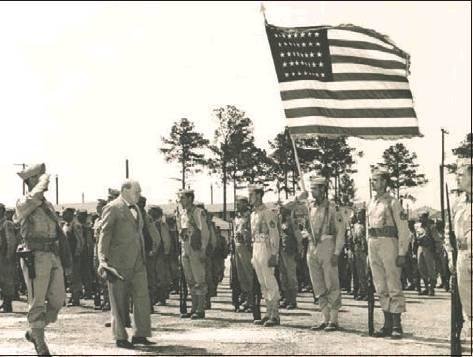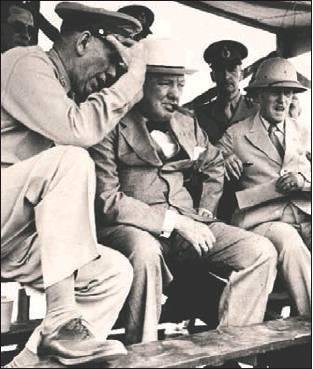Churchill’s visit to Fort Jackson forged a crucial military alliance
On June 6, 1944, more than 160,000 Allied troops landed along 50 miles of the heavily-fortified Normandy, France, beaches.
This was the opening assault on Nazi-held Europe.
2 years earlier, …
This item is available in full to subscribers.
Subscribe to continue reading. Already a subscriber? Sign in
Get 50% of all subscriptions for a limited time. Subscribe today.
Please log in to continueNeed an account?
|
Churchill’s visit to Fort Jackson forged a crucial military alliance
On June 6, 1944, more than 160,000 Allied troops landed along 50 miles of the heavily-fortified Normandy, France, beaches.
This was the opening assault on Nazi-held Europe.
2 years earlier, America’s direct involvement in World War II was barely 6-months old.
Our primary European ally, Great Britain, had reservations about the United States’ ability to train and deploy an army capable of contending with the German blitzkrieg.
On June 21, 1942, Winston Churchill, Great Britain’s Prime Minister, quietly slipped into Washington to meet with President Franklin Roosevelt to discuss the pending Allied invasion of North Africa.
While in the capitol, Churchill’s staff informed him of the fall of the North African port of Tobruk and the surrender of 30,000 Allied troops to German Gen. Erwin Rommel.
Churchill seemed quite disheartened when he met with Henry Stimson, the US Secretary of War, and General George Marshall, the Army Chief of Staff.
Churchill knew that the invasion of North Africa would pose a daunting challenge to America’s newly-rebuilt military. Looming just beyond the horizon waited the cross-channel invasion into France.
Churchill questioned if America’s Army would be ready in time. After a round of discussion, General Marshall decided a demonstration of American soldiers in training would better prove his point.
He recommended they travel to Fort Jackson to see firsthand the intensity to which American soldiers trained. Fort Jackson, an infantry training base which supported the training of 9 divisions, was the ideal choice.
Churchill and his entourage boarded the President’s train in Washington on the evening of June 23 and arrived at Fort Jackson at 11 am the following day. There to greet him were 9,600 soldiers representing the 8th, 30th, and 77th Infantry Divisions.
Column after column of soldiers, tanks, and artillery pieces passed in review for Churchill and his staff to inspect.
After the review, Churchill went to inspect airborne troops as they prepared for a static line jump against a simulated enemy airfield. Nearly 1,000 parachutists took part in this airborne assault. The paratroopers executed the air assault flawlessly.
After a brief lunch, Churchill was brought to the weapons range where he witnessed a simulated ground assault against an enemy ground position. The attack began with a Scout team locating the “enemy” stronghold and ended with an artillery barrage against that position.
Once again, the soldiers demonstrated impeccable discipline and competence.
Emboldened by his 5 ½-hour visit to Fort Jackson, Churchill headed back to England with a renewed faith in the Army’s ability to transform a massive number of civilians into combat-ready soldiers.
Reflecting after the war, Churchill wrote in his autobiography, “I greatly admired the manner in which the American Army was formed. I think it was a prodigy of organisation, of improvisation.
“There have been many occasions when a powerful state has wished to raise great armies, and with money and time and discipline and loyalty that can be accomplished.
“Nevertheless, the rate at which the small American Army of only a few hundred thousand men, not long before the war, created the mighty force of millions of soldiers is a wonder in military history.
“I was here two or three years ago, and visited with General Marshall all Army Corps being trained in South Carolina, and we saw there the spectacle of what you may call the mass production of divisions. In great and rapid rotation, they were formed, and moved on to further stages of their perfection.
“I saw the creation of this mighty force - this mighty Army, victorious in every theatre against the enemy in so short a time and from such a very small parent stock.
“This is an achievement which the soldiers of every other country will always study with admiration and with envy.”(Churchill, The Hinge of Fate, 1950, 347 – 348).
In support of World War II, Fort Jackson trained 270,000 soldiers, but it was the 5 ½-hours spent by Winston Churchill on the post that won over and solidified a crucial military alliance.
For more about Fort Jackson’s involvement in World War II, please visit the Basic Combat Training Museum or visit the Fort Jackson library. To arrange a tour, call 751-7419.
Henry Howe III is curator of Fort Jackson’s US Army Basic Training Museum.
Other items that may interest you










Comments
No comments on this item Please log in to comment by clicking here